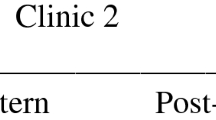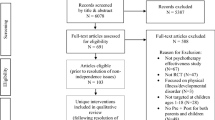Abstract
Parent involvement in the treatment of childhood disruptive behavior problems is a critical component of effective care. Yet little is known about the amount of time therapists are involving parents in treatment and factors that predict therapists’ efforts to involve parents in routine care. The purpose of this study is to examine therapists’ within-session involvement of parents in community-based outpatient mental health treatment. The data are from a larger longitudinal observational study of psychotherapy for children ages 4–13 with disruptive behavior problems and include videotaped psychotherapy sessions coded for the therapeutic strategies delivered as well as measures of child, parent/family, and therapist characteristics at baseline. Parent involvement is defined as the proportion of time in the session that therapists direct treatment strategies towards parents. Results indicated that therapists directed treatment strategies towards parents an average of 44% of the time within a session. Multilevel modeling was used to examine client-level (child, parent, and family functioning) and provider-level (therapist experience and background) predictors of parent involvement. Therapists involved parents more when the child had higher levels of behavior problems, when the parent reported higher levels of internalized caregiver strain, and when the therapist was more experienced. The results highlight potential areas to target in efforts to increase parent involvement, including training less experienced therapists to increase their focus on directing strategies towards parents.
Similar content being viewed by others
References
Baker-Ericzén, M. J., Jenkins, M. M., & Haine-Schlagel, R. (under review). Therapist, parent, and youth perspectives of treatment barriers to family-focused community outpatient mental health child services.
Beauchaine, T. P., Webster-Stratton, C., & Reid, M. J. (2005). Mediators, moderators, and predictors of 1-year outcomes among children treated for early-onset conduct problems: A latent growth curve analysis. Journal of Consulting and Clinical Psychology, 73, 371–388.
Brannan, A. M., Heflinger, C. A., & Bickman, L. (1997). The caregiver strain questionnaire: Measuring the impact on the family living with a child with serious emotional disturbance. Journal of Emotional and Behavioral Disorders, 5, 212–222.
Brannan, A. M., Heflinger, C. A., & Foster, E. M. (2003). The role of caregiver strain and other family variables in determining children’s use of mental health services. Journal of Emotional and Behavioral Disorders, 11, 78–92.
Brookman-Frazee, L., Haine, R. A., Baker-Ericzén, M., Zoffness, R., & Garland, A. F. (2010). Factors associated with use of evidence-based practice strategies in usual care youth psychotherapy. Administration & Policy in Mental Health & Mental Health Services Research, 37, 254–269.
Brookman-Frazee, L., Haine, R. A., Gabayan, E. N., & Garland, A. F. (2008). Predicting frequency of treatment visits in community-based youth psychotherapy. Psychological Services, 5, 126–138.
Cunningham, P. B., & Henggeler, S. W. (1999). Engaging multiproblem families in treatment: Lessons learned throughout the development of multisystemic therapy. Family Process, 38, 265–281.
DeGarmo, D. S., Chamberlain, P., Leve, L. D., & Price, J. (2009). Foster parent intervention engagement moderating child behavior problems and placement disruption. Research on Social Work Practice, 19, 423–433.
Derogatis, L. R., & Melisaratos, N. (1983). The brief symptom inventory: An introductory report. Psychological Medicine, 13, 595–605.
Dowell, K. A., & Ogles, B. M. (2010). The effects of parent participation on child psychotherapy outcome: A meta-analytic review. Journal of Clinical Child & Adolescent Psychology, 39, 151–162.
Earls, F. J. (1994). Violence and today’s youth. Critical Issues for Children and Youth, 4, 4–23.
Eyberg, S. M., Nelson, M. M., & Boggs, S. R. (2008). Evidence-based psychosocial treatments for children and adolescents with disruptive behavior. Journal of Clinical Child and Adolescent Psychology, 37, 215–237.
Eyberg, S. M., & Pincus, D. (1999). Eyberg child behavior inventory and Sutter-Eyberg student behavior inventory—revised: Professional manual. Odessa, FL: Psychological Assessment Resources.
Garland, A. F., Accurso, E. C., & Haine-Schlagel, R. (2010a). Treatment processes associated with outcomes in usual care therapy for children. San Francisco, CA: Paper presented at the Association for Behavioral and Cognitive Therapies Convention.
Garland, A. F., Brookman-Frazee, L., Hurlburt, M., Arnold, E., Zoffness, R., Haine-Schlagel, R., et al. (2010b). Mental health care for children with disruptive behavior problems: A view inside therapists’ offices. Psychiatric Services, 61, 788–795.
Garland, A. F., Hawley, K. M., Brookman-Frazee, L., & Hurlburt, M. S. (2008). Identifying common elements of evidence-based psychosocial treatments for children’s disruptive behavior problems. Journal of the American Academy of Child and Adolescent Psychiatry, 47, 505–514.
Garland, A. F., Hough, R. L., McCabe, K. M., Yeh, M., Wood, P. A., & Aarons, G. A. (2001). Prevalence of psychiatric disorders in youths across five sectors of care. Journal of the American Academy of Child and Adolescent Psychiatry, 40, 409–418.
Garland, A. F., Hurlburt, M. S., Brookman-Frazee, L., Taylor, R. M., & Accurso, E. C. (2010c). Methodological challenges of characterizing usual care psychotherapeutic practice. Administration and Policy in Mental Health and Mental Health Services Research, 37, 208–220.
Glisson, C., Landsverk, J., Schoenwald, S., Kelleher, K., Hoagwood, K. E., Mayberg, S., et al. (2008). Assessing the organizational social context (OSC) of mental health services: Implications for research and practice. Administration and Policy in Mental Health and Mental Health Services Research, 35, 98–113.
Hawley, K. M., & Weisz, J. R. (2005). Youth versus parent working alliance in usual clinical care: Distinctive associations with retention, satisfaction, and treatment outcome. Journal of Clinical Child and Adolescent Psychology, 34, 117–128.
Hoge, R. D., Andrews, D. A., Faulkner, P., & Robinson, D. (1989). The family relationship index: Validity data. Journal of Clinical Psychology, 45, 897–903.
Holahan, C. J., & Moos, R. H. (1983). The quality of social support: Measures of family and work relationships. British Journal of Clinical Psychology, 22, 157–162.
Huang, L., Stroul, B., Friedman, R., Mrazek, P., Friesen, B., Pires, S., et al. (2005). Transforming mental health care for children and their families. American Psychologist, 60, 615–627.
Ireland, J. L., Sanders, M. R., & Markie-Dadds, C. (2003). The impact of parent training on marital functioning: A comparison of two group versions of the Triple P- positive parenting program for parents of children with early-onset conduct problems. Behavioural and Cognitive Psychotherapy, 31, 127–142.
Israel, P., Thomsen, P. H., Langeveld, J. H., & Stormark, K. M. (2007). Child factors associated with parent involvement in usual clinical care of children and adolescents: A national register study. Nordic Journal of Psychiatry, 61, 173–181.
Jackson, H., Frick, P., & Dravage-Bush, J. (2000). Perceptions of control in children with externalizing and mixed behavior disorders. Child Psychiatry and Human Development, 31, 43–58.
Karver, M. S., Handelsman, J. B., Fields, S., & Bickman, L. (2006). Meta-analysis of therapeutic relationship variables in youth and family therapy: The evidence for different relationship variables in the child and adolescent treatment outcome literature. Clinical Psychology Review, 26, 50–65.
Kazak, A. E., Hoagwood, K., Weisz, J. R., Hood, K., Kratochwill, T. R., Vargas, L. A., et al. (2010). A meta-systems approach to evidence-based practice for children and adolescents. American Psychologist, 65, 85–97.
Kazdin, A. E., Siegel, T. C., & Bass, D. (1990). Drawing on clinical practice to inform research on child and adolescent psychotherapy: Survey of practitioners. Professional Psychology: Research and Practice, 21, 189–198.
Muthén, L. K., & Muthén, B. O. (2010). Mplus version 6.1 [Computer Software]. Los Angeles, CA: Muthén & Muthén.
Nix, R. L., Bierman, K. L., McMahon, R. J., & The Conduct Problems Prevention Research Group. (2009). How attendance and quality of participation affect treatment response to parent management training. Journal of Consulting and Clinical Psychology, 77, 429–438.
Nock, M. K., & Ferriter, C. (2005). Parent management of attendance and adherence in child and adolescent therapy: A conceptual and empirical review. Clinical Child and Family Psychology Review, 8, 149–166.
Pellerin, K., Costa, N., Weems, C. F., & Dalton, R. F. (2010). An examination of treatment completers and non-completers at a child and adolescent community mental health clinic. Community Mental Health Journal, 46, 273–281.
Radloff, L. S. (1977). The CES-D scale: A self-report depression scale for research in the general population. Applied Psychological Measurement, 1, 385–401.
Raudenbush, S., Bryk, R., & Congdon, A. (2004). HLM [computer software]. Lincolnwood, IL: Scientific Software International.
Reyno, S. M., & McGrath, P. J. (2006). Predictors of parent training efficacy for child externalizing behavior problems—a meta-analytic review. Journal of Child Psychology and Psychiatry, 47, 99–111.
Richards, M. M., Bowers, M. J., Lazicki, T., Krall, D., & Jacobs, A. K. (2008). Caregiver involvement in the intensive mental health program: Influence on changes in child functioning. Journal of Child and Family Studies, 17, 241–252.
Schoenwald, S. K., Brown, T. L., & Henggeler, S. W. (2000). Inside multisystemic therapy: Therapist, supervisory, and program practices. Journal of Emotional and Behavioral Disorders, 8, 113–127.
Southam-Gerow, M. A., Ringeisen, H. L., & Sherrill, J. T. (2006). Integrating interventions and services research: Progress and prospects. Clinical Psychology: Science and Practice, 13, 1–8.
Staudt, M. (2007). Treatment engagement with caregivers of at-risk children: Gaps in research and conceptualization. Journal of Child and Family Studies, 16, 183–196.
Taylor-Richardson, K. D., Heflinger, C. A., & Brown, T. N. (2006). Experience of strain among types of caregivers responsible for children with serious emotional and behavioral disorders. Journal of Emotional and Behavioral Disorders, 14, 157–168.
Verduin, T. L., & Kendall, P. C. (2003). Differential occurrence of comorbidity within childhood anxiety disorders. Journal of Clinical Child and Adolescent Psychology, 32, 290–295.
Weisz, J. R., & Jensen, A. L. (2001). Child and adolescent psychotherapy in research and practice contexts: Review of the evidence and suggestions for improving the field. European Journal of Child and Adolescent Psychiatry, 10, 12–18.
Acknowledgments
Preparation of this article was supported by the following NIMH grants: R01-MH66070 (AG); K23-MH080149 (RHS); K23-MH077584 (LBF); K01-MH069665 (MBE). Additionally, Dr. Brookman-Frazee is an investigator with the Implementation Research Institute (IRI), at the George Warren Brown School of Social Work, Washington University in St. Louis; through an award from the National Institute of Mental Health (R25 MH080916) and the Department of Veterans Affairs, Health Services Research & Development Service, Quality Enhancement Research Initiative (QUERI). The authors thank Scott Roesch, PhD for assistance with data analysis. We also thank William Ganger, MA for assistance with data management, as well as Deb Dupuis, MPH and Robin Taylor for project management and the families and therapists who participated in this study.
Author information
Authors and Affiliations
Corresponding author
Rights and permissions
About this article
Cite this article
Haine-Schlagel, R., Brookman-Frazee, L., Fettes, D.L. et al. Therapist Focus on Parent Involvement in Community-Based Youth Psychotherapy. J Child Fam Stud 21, 646–656 (2012). https://doi.org/10.1007/s10826-011-9517-5
Published:
Issue Date:
DOI: https://doi.org/10.1007/s10826-011-9517-5




